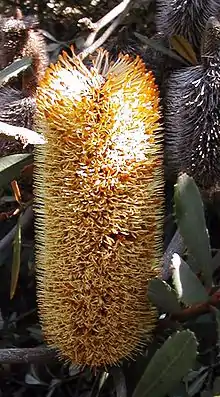Banksia penicillata
Banksia penicillata is a species of shrub that is endemic to a restricted area of New South Wales. It has smooth bark, serrated, elliptic to egg-shaped leaves, green to bluish flower buds, later yellow flowers in a cylindrical spike, and later still, up to one hundred narrow elliptical follicles in each spike, surrounded by the remains of the flowers.
| Banksia penicillata | |
|---|---|
 | |
| Banksia penicillata in Maranoa Gardens | |
| Scientific classification | |
| Kingdom: | Plantae |
| Clade: | Tracheophytes |
| Clade: | Angiosperms |
| Clade: | Eudicots |
| Order: | Proteales |
| Family: | Proteaceae |
| Genus: | Banksia |
| Species: | B. penicillata |
| Binomial name | |
| Banksia penicillata | |
| Synonyms[1] | |
| |
Description
Banksia penicillata is a shrub that typically grows to a height of 4 m (13 ft) and has smooth bark but does not form a lignotuber. The leaves are arranged in whorls and are 35–120 mm (1.4–4.7 in) long and 7–40 mm (0.28–1.57 in) wide on a petiole 5–19 mm (0.20–0.75 in) long. The sides of the leaves are serrated or lobed and the lower surface is covered with woolly white hairs. The flower buds are green to bluish and are followed by yellow flowers in a cylindrical spike 70–190 mm (2.8–7.5 in) long with woolly-hairy involucral bracts 10–20 mm (0.39–0.79 in) long at the base of the spike. The perianth is 20–26 mm (0.79–1.02 in) long and the pistil 22–26 mm (0.87–1.02 in) long and slightly curved. Flowering occurs from March to June and up to one hundred elliptical follicles 11–15 mm (0.43–0.59 in) long and surrounded by the remains of the flowers, develop in each spike.[2][3][4]
Taxonomy and naming
Banksia conferta was first formally described in 1981 by Alex George in the journal Nuytsia. In the same publication he described two varieties, conferta and penicillata.[5][6] In 1996, George raised the variety penicillata to subspecies - B. conferta subsp. penicillata, at the same time creating the autonym B. conferta subsp. conferta.[7][8] In the same year (1996), Kevin Thiele and Pauline Ladiges raised subspecies penicillata to species status as B. penicillata in Australian Systematic Botany, and the change is accepted by the Australian Plant Census.[1][9] The specific epithet (penicillata) is from the Latin word penicillatus, meaning "like an artist's camel-hair brush.[10][11]
Distribution and habitat
Banksia penicillata grows on and near rocky sandstone cliffs in forest and woodland in a few locations in the Blue Mountains west of Sydney.
Ecology
This banksia does not have a lignotuber but the follicles remain closed until burnt in a bushfire. The plant is killed by fire but regenerates from seed.[2][10]
References
- "Banksia penicillata". Australian Plant Census. Retrieved 22 May 2020.
- George, Alex S. (1999). Flora of Australia (PDF). 17B. Canberra: Australian Biological Resources Study, Canberra. pp. 191–192. Retrieved 22 May 2020.
- Harden, Gwen J. "Banksia conferta". Royal Botanic Garden Sydney. Retrieved 22 May 2020.
- George, Alex S. (1996). The Banksia Book (3rd ed.). Kenthurst, New South Wales: Kangaroo Press. p. 56. ISBN 0-86417-818-2.
- George, Alex S. (1981). "The Genus Banksia L.f. (Proteaceae)". Nuytsia. 3 (3): 284–291. Retrieved 22 May 2020.
- "Banksia conferta var. penicillata". APNI. Retrieved 22 May 2020.
- "Banksia conferta subsp. penicillata". APNI. Retrieved 22 May 2020.
- George, Alex S. (1996). "Notes on Banksia L.f. (Proteaceae). Nuytsia". Nuytsia. 11 (1): 22. Retrieved 22 May 2020.
- "Banksia penicillata". APNI. Retrieved 22 May 2020.
- "Banksia penicillata". Australian Native Plants Society (Australia). Retrieved 22 May 2020.
- William T. Stearn (1992). Botanical Latin. History, grammar, syntax, terminology and vocabulary (4th ed.). Portland, Oregon: Timber Press. p. 463.